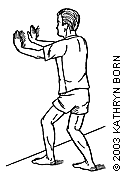
Am Fam Physician. 2003;67(2):375-376
What causes an injury in a runner?
Most injuries that affect runners are called overuse injuries. This type of injury most often occurs because the runner is trying to run too far, too fast, and too soon. With every mile you run, your feet must absorb about 110 tons of energy. Up to 70 percent of runners get hurt every year.
How can overuse injury be prevented?
You can decrease your risk of getting hurt by following these recommendations:
Do not increase running mileage by more than 10 percent per week.
Do not run more than 45 miles per week. There is little evidence that running more than 45 miles per week improves your performance, but there is a great deal of evidence that running more than that increases your risk for an overuse injury.
Do not run on slanted or uneven surfaces. The best running surface is soft, flat terrain.
Do not “run through pain.” Pain is a sign that something is wrong.
If you have muscle pain when you run, put ice on the area and rest for two or three days. If the pain continues for a week, see your doctor.
Follow hard training or running days with easy days.
Get new running shoes every 500 miles.
What about inserts to reduce the chance of injury?
Orthotics are inserts that are put in shoes to correct bad alignment between the foot and the lower leg. You will probably need inserts if you have a problem called pronation, which means that the inside of the foot turns in. If you have bad alignment but no pain with running and you do not suffer from repeated injuries, you probably do not need inserts. Many world-class athletes with bad alignment do not use inserts. However, your doctor may suggest inserts if you have bad alignment and become injured and do not get better with other measures, such as rest, ice application, and cross-training.
What exercises help prevent or treat injuries?
Before and after a run, perform specific stretching exercises. See the pictures below and on the next page for examples. These exercises also may be part of your recovery from an injury. With each exercise, hold the stretch for at least 15 seconds and do not bounce. Repeat each stretch six to eight times. Stretch until you feel tension but not pain. If you develop an injury, your doctor may suggest particular strengthening exercises.
Stretching exercises Hamstring stretch
Sit with your injured leg straight and your other leg bent. With your back straight and your head up, slowly lean forward at your waist. You should feel the stretch along the underside of your thigh.
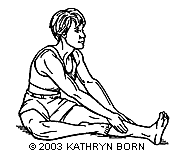
Iliotibial band stretch
Sit with your injured leg bent and crossed over your straightened opposite leg. Twist at your waist away from your injured leg, and injured leg across should feel the side of your hip.
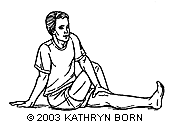
Groin stretch
Sit with your feet together, your back straight, your head up, and your elbows on the inside of your knees. Then slowly push down inside of your knees elbows. You should the stretch along the of your thighs.
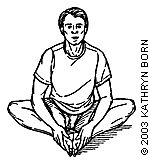
Quadriceps stretch
Stand straight with your injured leg bent. Grasp the foot of your injured leg with your hand and slowly pull your heel up to your buttocks. You should feel the stretch in the front of your thigh.
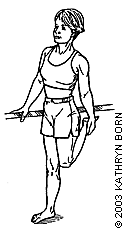
Calf stretch
Stand with your hands against a wall and your injured leg behind your other leg. With your injured leg straight, your heel flat on the floor, and your foot pointed straight ahead, lean slowly forward, bending the other leg. You should feel the stretch in the middle of your calf.
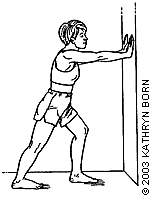
Plantar fascia stretch
Stand straight with your hands against a wall and your injured leg slightly behind your other leg. Keeping your heels flat on the floor, slowly bend both knees. You should feel the stretch in the lower part of your leg.
